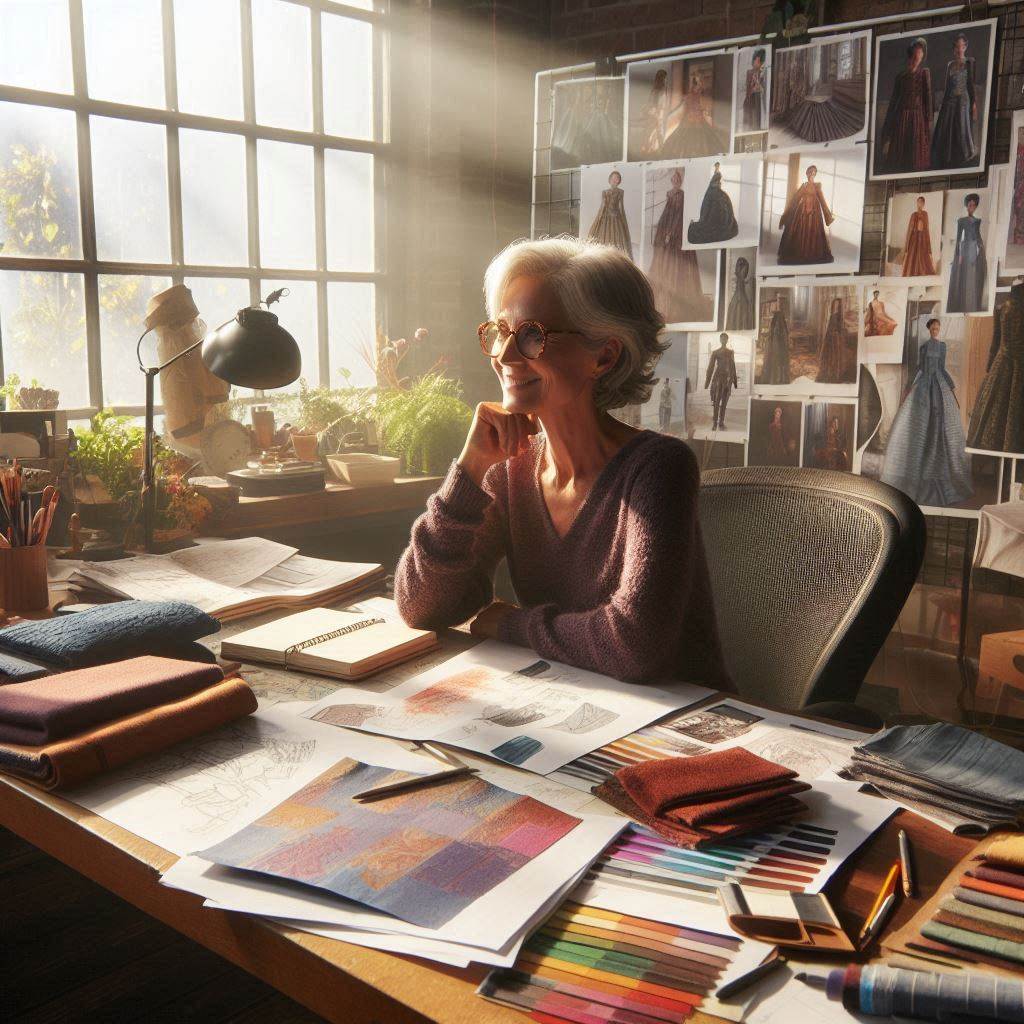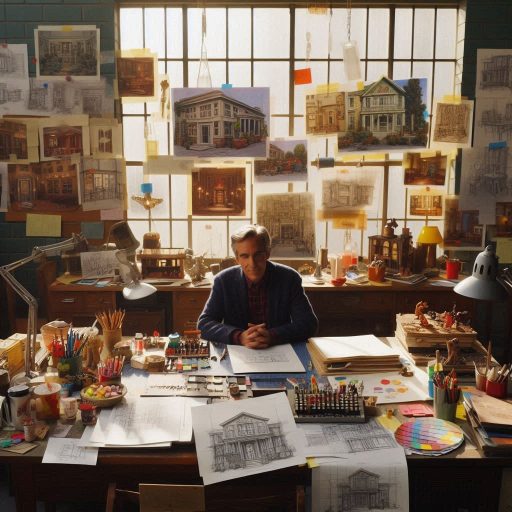Introduction
Film set design is an integral part of creating the visual identity of a movie.
It serves as the backbone for setting the tone, atmosphere, and emotional impact of a film.
Every element of a set, from its architecture to the smallest prop, contributes to shaping the world in which characters exist and interact.
Through meticulous planning, set designers craft environments that not only reflect the narrative but also engage the audience on a deeper emotional level.
Whether it’s a humble home, a bustling metropolis, or an alien landscape, the set design acts as the canvas for the entire story.
In essence, film set design is much more than the physical creation of a scene—it’s an art form that enhances the emotional depth and visual storytelling of a movie.
Effective set design enhances the narrative and becomes a memorable part of the audience’s experience. It plays a crucial role in filmmaking.
Overview of Iconic Film Set Designs
When it comes to iconic film set designs, there are certain locations that have become synonymous with the movies themselves.
These set designs have not only captivated audiences but have also influenced future filmmakers and designers in the industry.
One of the most crucial aspects of a film is its set design.
The way a location is visually crafted can set the tone for the entire movie and immerse viewers in a world created by the filmmakers.
Famous film set designs
Several film set designs have left a lasting impact on cinematic history.
These iconic locations have captured the imagination of audiences worldwide and become ingrained in popular culture.
The Overlook Hotel from “The Shining”
The sinister and eerie design of the Overlook Hotel in Stanley Kubrick’s “The Shining” has become one of the most iconic film sets in history.
The hotel’s labyrinthine corridors and ominous atmosphere perfectly complement the movie’s psychological horror elements.
The Emerald City from “The Wizard of Oz”
The technicolor grandeur of the Emerald City in “The Wizard of Oz” is a visual spectacle that has stood the test of time.
The vibrant colors and fantastical architecture of the city have made it a beloved landmark in film history.
Influence on future filmmakers and designers
Iconic film set designs captivate audiences and inspire filmmakers and designers to push creative boundaries in their work.
Filmmakers and designers should pay meticulous attention to detail in their iconic film sets.
These sets serve as benchmarks for creating immersive and visually stunning movie worlds.
By studying these iconic designs, aspiring creatives can learn valuable lessons in set design, world-building, and storytelling.
The lasting impact of these film sets proves that a well-crafted location can elevate a movie from good to unforgettable.
Iconic film set designs like the Overlook Hotel from “The Shining” and the Emerald City from “The Wizard of Oz” greatly impacted cinematic history.
Their memorable visuals continue to influence filmmakers today.
These locations serve as more than mere backgrounds in movies.
They act as characters, shaping narratives and influencing the creative direction of future projects.
Aspiring filmmakers and designers can draw inspiration from these iconic designs and strive to create their own memorable and visually striking movie worlds.
Read: Top Skills Needed for a Successful Character Designer
Importance of Film Set Design in Storytelling
Set design is a crucial element in storytelling within the realm of film.
It sets the stage for the narrative, establishing the world in which the characters exist.
From grandiose landscapes to intimate interiors, the design of a film set can greatly impact the audience’s perception of the story being told.
- Creates an immersive experience for the audience.
- Sets the tone and atmosphere of the film.
- Enhances the overall visual storytelling of the movie.
Set designers work closely with directors and cinematographers to ensure that the visual elements of the film align with the director’s vision.
They collaborate to bring the script to life, making creative decisions about the look and feel of each scene.
Every detail, from the color palette to the placement of furniture, is carefully considered to enhance the storytelling experience for the audience.
Exploring How Film Set Design Conveys Theme, Tone, and Atmosphere
- Set design can establish the time period and location of the story.
- Choice of props and decor can reveal character traits and motivations.
- Lighting and color schemes can evoke specific emotions in the audience.
By paying attention to these details, set designers can effectively convey the themes and messages of the film.
For example, a cluttered, disorganized set might suggest chaos or instability in the characters’ lives, while a sleek, minimalist design could imply sophistication or control.
The design of a film set can communicate nuances that words alone cannot express, adding depth and complexity to the story.
Collaboration Between Set Designers, Directors, and Cinematographers
- Set designers collaborate with the director to understand their vision for the film.
- They work with cinematographers to ensure that the lighting and camera angles complement the set design.
- Together, they aim to create a visually cohesive and compelling world for the audience to explore.
Successful collaboration between set designers, directors, and cinematographers is essential for creating a cohesive visual language in a film.
Each team member contributes unique perspectives and expertise.
They collaborate to create a visually stunning and narratively rich experience for the audience.
Enhancing the Storytelling Experience Through Set Design Details
- Attention to detail can elevate the authenticity of the world being portrayed.
- Subtle clues in the set design can foreshadow plot developments or character arcs.
- Well-thought-out set design can elevate the overall production value of a film.
From intricate period pieces to futuristic sci-fi worlds, the design of a film set can transport audiences to new and exciting realms.
Every element of the set, no matter how small, contributes to the storytelling experience, immersing viewers in the world of the film.
Set designers play a crucial role in shaping the visual language of a movie, bringing the director’s vision to life in a tangible and unforgettable way.
Read: Career Paths in Ceramic Art and Design
Impact on audience perception
Film set designs play a crucial role in shaping how audiences perceive and interpret a movie.
A well-crafted set goes beyond aesthetics; it creates an immersive experience that can profoundly influence the viewer’s emotional connection to the story.
Here’s how film set designs impact audience perception:
Immersion in the Film’s World
A well-designed set can transport viewers into the film’s universe.
When the environment reflects the film’s themes, time period, and mood, it enhances the audience’s ability to suspend disbelief.
For instance, in Blade Runner, the dystopian cityscape immerses viewers in a futuristic, neon-lit world, effectively conveying themes of isolation and technological advancement.
Such environments allow audiences to experience the characters’ journeys more vividly.
Emotional Connection to the Story
The emotional connection between viewers and the narrative is often strengthened by the set design.
The choice of colors, materials, and spatial arrangements can evoke specific feelings.
For example, a warm, cozy home can create feelings of safety and nostalgia, while a stark, cold environment may elicit discomfort and tension.
This emotional resonance helps audiences empathize with characters and their experiences, deepening their investment in the story.
Iconic Set Designs as Characters
Certain film sets become iconic in their own right, contributing significantly to a movie’s identity.
Consider the lush, vibrant landscapes of Avatar or the hauntingly beautiful mansion in The Shining.
These environments are so intricately tied to the films that they influence how audiences remember and discuss them.
An iconic set can embody the themes and emotions of the film, making it a character in its own right.
Such memorable designs often leave a lasting impression, affecting how viewers perceive the story long after the credits roll.
Film set designs actively shape audience perception.
They create immersive environments that enhance emotional connections.
These designs contribute significantly to storytelling.
A well-crafted set can transport viewers into a film’s world, evoke powerful emotions, and become iconic elements that define the cinematic experience.
Filmmakers should recognize the power of set design in shaping audience perceptions and harness this element to enhance their storytelling efforts.
Read: Freelance Character Design: How to Get Started

Cultural significance of iconic film set designs
Film set designs play a crucial role in shaping the visual narrative of a movie and creating the atmosphere of the story.
Iconic film set designs have the power to become cultural touchstones and leave a lasting impact on popular culture.
Influence on popular culture
Iconic film set designs often become iconic landmarks in popular culture, instantly recognizable and deeply ingrained in the minds of audiences.
These designs can inspire fan art, merchandise, and even theme park attractions, extending the reach of the movie beyond the screen.
From the Overlook Hotel in “The Shining” to the Hogwarts Castle in “Harry Potter,” these iconic designs have become synonymous with the movies themselves.
Transform Your Career Today
Unlock a personalized career strategy that drives real results. Get tailored advice and a roadmap designed just for you.
Start NowTranscending the movie
Iconic film set designs have the ability to transcend the movie itself and become symbols of a particular era or genre.
For example, the futuristic cityscape of “Blade Runner” has come to represent a dystopian vision of the future in popular culture.
Similarly, the gothic architecture of the Batcave in various Batman movies has become synonymous with the dark and brooding world of the superhero.
In fact, iconic film set designs hold a special place in the hearts of moviegoers, not just for their aesthetic appeal, but for the cultural significance they carry.
They have the power to inspire creativity, spark imagination, and become timeless symbols of the movies they represent.
Read: Career Paths: Becoming a Professional Character Designer
The Evolution of Film Set Design
The evolution of film set design has been a fascinating journey, reflecting changes in technology, artistic expression, and cultural landscapes.
From the early days of silent cinema to today’s visually stunning blockbusters, set design has transformed significantly, shaping the cinematic experience.
Early Days of Silent Cinema
In the silent film era, set design was primarily focused on realism and theatricality.
Filmmakers often constructed elaborate backdrops to create immersive worlds, relying on painted scenery and practical effects.
Filmmakers created grand sets in films like The Birth of a Nation (1915) and Metropolis (1927).
These sets transported audiences to different time periods and locations.
The constraints of technology limited the scope of set design, but creativity flourished within those boundaries.
Technological Advances and Cultural Shifts
The introduction of sound in the late 1920s changed the filmmaking landscape.
As dialogue became a crucial component, filmmakers began to create sets that reflected the characters’ environments more accurately.
The rise of color film in the 1930s and 1940s further enhanced the artistic possibilities of set design.
Iconic films like The Wizard of Oz (1939) showcased vibrant, imaginative sets that captured audiences’ imaginations.
The 1960s and 1970s saw a shift toward more experimental and stylized set designs.
Filmmakers like Stanley Kubrick in 2001: A Space Odyssey (1968) used innovative designs and practical effects to create immersive experiences.
The changing cultural landscape influenced film themes and aesthetics.
This shift led to diverse and avant-garde set designs.
These designs reflected societal changes and new artistic movements.
Contemporary Innovations
Today, technological advancements have revolutionized film set design.
Digital effects, CGI, and virtual production techniques allow filmmakers to create visually striking and imaginative worlds.
Films like Avatar (2009) and Dune (2021) showcase contemporary filmmakers pushing boundaries with innovative set designs.
They blend physical sets with digital enhancements effectively.
This integration creates more immersive experiences for viewers, blurring the lines between reality and fantasy.
Moreover, the rise of streaming platforms has increased the demand for high-quality production values, leading filmmakers to invest more in elaborate set designs.
Creative teams continuously experiment with new materials, construction techniques, and technologies to craft sets that captivate audiences and elevate storytelling.
In general, the evolution of film set design reflects a dynamic interplay of technology, culture, and artistic vision.
From the simplistic backdrops of silent cinema to the immersive worlds of modern blockbusters, set design has become an essential aspect of filmmaking.
As technology advances, contemporary filmmakers push the boundaries of creativity.
They shape the future of set design in exciting, innovative ways.
The Process of Creating Iconic Film Set Designs
Creating iconic film set designs is a meticulous process that requires a team of skilled professionals to bring a director’s vision to life.
From research and concept development to construction and final touches, every step is crucial to the success of the project.
Research and Concept Development
- Set designers begin by studying the script and discussing the director’s vision for the film.
- They conduct research to gather inspiration and ideas for the design, including historical references and artistic influences.
- Concept sketches and mood boards are created to visualize the overall look and feel of the set.
Collaboration between Set Designers and Art Directors
- Set designers work closely with art directors to ensure that the set design aligns with the overall aesthetic of the film.
- They collaborate on color schemes, textures, and lighting to create a cohesive visual experience for the audience.
- Art directors provide valuable input and guidance throughout the design process.
Construction and Final Touches
Once the design is finalized, construction begins on the film set, with set decorators adding props and details to enhance the authenticity of the environment.
Every detail, from furniture to wallpaper, is carefully selected to create a realistic and immersive setting for the actors and audience.
The finishing touches, such as paint finishes and aging techniques, help to bring the set to life on screen.
Attention to Detail and Craftsmanship
Creating a memorable and visually stunning film set requires an extraordinary level of attention to detail and craftsmanship.
Set designers must possess a keen eye for composition, color, and spatial relationships to create a believable and immersive world for the film.
Every element of the set, from the architecture to the props, must be carefully curated to enhance the story and evoke the desired emotions from the audience.
This level of detail is what sets iconic film sets apart from the rest and leaves a lasting impression on viewers.
Ultimately, the collaboration between set designers, art directors, and production designers is essential in bringing a director’s vision to life on screen.
Their creativity, expertise, and dedication to craftsmanship combine to create film sets that are works of art.
These sets enrich the overall cinematic experience for audiences worldwide.
Conclusion
Iconic film set designs play a crucial role in creating memorable cinematic experiences.
They set the tone, enhance the storytelling, and transport audiences to different worlds.
The impact of well-crafted film sets cannot be underestimated as they contribute significantly to the overall success and longevity of a movie.
Appreciating film set designs requires recognizing the artistry, creativity, and meticulous attention to detail involved.
Designers skillfully solve problems to bring a director’s vision to life, demonstrating exceptional creativity and precision.
Studying iconic film sets in favorite movies allows us to appreciate the craftsmanship and innovation behind these immersive environments.
We should actively analyze film design choices and recognize the skill of production designers and set decorators.
These professionals work tirelessly behind the scenes to create movie magic.
By engaging with film set design, we can enhance our viewing experience and develop a greater understanding of the visual language of cinema.
Next time you watch a movie, notice how the sets and backgrounds shape the story and atmosphere.
Consider the emotions they evoke.
By focusing on film set designs, you will discover new storytelling layers that enrich your experience.
[E-Books for Sale]
The Big Book of 500 High-Paying Jobs in America: Unlock Your Earning Potential
$19.99 • 500 High-Paying Jobs • 330 pages
Explore 500 high-paying jobs in America and learn how to boost your career, earn more, and achieve success!
See All 500 High-Paying Jobs of this E-Book
1001 Professions Without a Degree: High-Paying American Jobs You Can Start Now
$19.99 • 1001 Professions Without a Degree • 174 pages
Discover 1001 high-paying jobs without a degree! Unlock career tips, skills, and success strategies for just $19.99!




